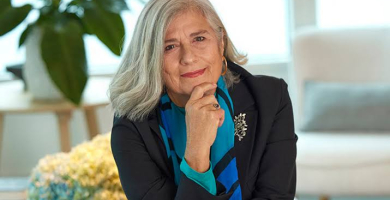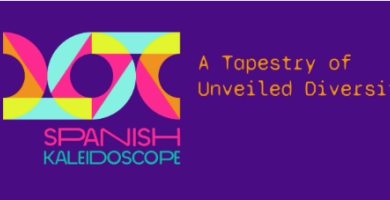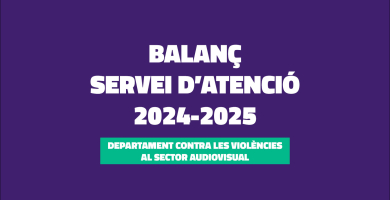
MARC DOMINICI: “There’s a constant evolution of formats and needs, the platforms ask you for a specific class of deliveries and technologies and we’re constantly updating.”
This month we interview Marc Dominici, postproduction supervisor for Antaviana, a company specialized in VFX and postproduction who has worked on projects shot in Barcelona such as Creatura, A Thief’s Daughter, The Cuckoo’s Curse, Selftape, Smiley and Bojos per Molière.

What does your day to day work in Antaviana consist of?
I carry out the technical supervision of all the methodologies and workflows that are followed, as well as the supervision of the postproductions underway. There is a more artistic part which also involves the director, Bernat, as well as some more creative departments: effects, graphics, colour. I ensure everything goes well and that this creative department can express itself. I also channel all the material. Postproduction is increasingly complex as regards management of materials, equipment... I work together with the coordination and production department; they manage the equipment and clients more, and I make sure everything works and distribute the materials to all the departments.
Some films don’t appear to have much postproduction but they do. Is that the magic of postproduction?
It’s one of the magical aspects that have traditionally been attributed to postproduction, but I like to point out that it’s just one of the aspects. All the fixed shots, the deletions so that you don’t see an electrical panel in a period film... You help the production to streamline expenses and to solve many possible problems which have arisen during the shooting. Even a simple image stabilization. You devote time to ensure this possible shooting defect isn’t noted. The opposite occurs too: you have something very fixed and they want it more like a camera on the shoulder. Then you give it a sort of natural movement, which isn’t repetitive, etc.… You perform a lot of actions on a film and part of the fun is that it shouldn’t be noted.
Is colour correction one of these interventions? What does this process consist of?
I always like to say - half serious, half joking - that cinema is a big lie. You have an appearance of reality and of continuity which hasn’t been respected or wasn’t carried out during the shoot for logistic, production or budgetary reasons. Different sequences are shot at different times and even different shots of the same sequence are filmed at different times of the day. In a film shot outside you sometimes have clouds, it might rain, and the light conditions change.
Colour correction is useful on two levels. First, so that shots filmed at different times match and have the same characteristics. The audience shouldn’t notice that there’s a difference, because otherwise this artefact which is the world of cinema would lose stability and the illusion would fall apart.
Second, we have the creative part which for me is the most important and the one we enjoy the most. The photography is obviously defined by the director of photography with specific intentions and lighting, but then in postproduction what we do is to observe this creative work and take it to a higher level if the conditions are favourable. What do I mean by that? Cooling down or warming up the image. We begin all the operations, what I call intraframe, within the frame. Sometimes we make masks to focus the gaze more, darkening around it. Or we select colours so that the audience’s sight isn’t attracted to a background with a very blue colour, lowering the intensity of such an intense blue. Why do the actors in American series all have such beautiful eyes? Are they superior? No. Sometimes they make masks devoted to their eyes; the saturation of the eyes is highlighted and it cracks with the movement of the face. There’s a whole series of operations that support the aesthetic idea of the director of photography and which also determine where the audience looks and all that work inside and outside the frame. So you can make things as beautiful as a western which isn’t the typical toasted, brownish image, but rather cold because the story wants to tell you something else. There can also be an evolution of colour between the beginning of the film and the end. Or you can establish colour codes reinforced by the art direction. All this comes from prior ideas. What we do is to strengthen it or even propose new things.
Is that why postproduction has to be in the project right from the beginning?
You’re talking about this idea of “we’ll arrange it in postproduction”, which is one of the images that I’d like to get rid of. I prefer to invest time before rather than solving certain things when they’ve already been shot, because that’s very complicated. We like to come in during preproduction, script reading and offer advice about what can or can’t be done and what cost certain solutions or effects that are proposed in the script may have. We also help design the whole workflow, not so much as regards the shooting but rather management of the material in the shoot, backups, how this transcoding will be carried out so that the editor can work... There are two reasons why we like to come in earlier. Mainly, to help and not find ourselves with “we’ll arrange it in postproduction”, which normally means time and money. And the other reason is that it helps share out the tasks more. Although previously the world of postproduction was somewhat more limited, nowadays it’s becoming increasingly important. For example, we can see whether filming with a certain type of camera will save you money later on when it comes to chroma keying and adding certain effects. It helps us a little more to qualify or help the director of production to implement or better distribute the efforts.
What other services does Antaviana offer?
We try to offer a comprehensive postproduction service. We like to come in during preproduction, and we also attend the shooting of certain sequences of effects, we receive the material with backups of the shoot, editing, sound mixing, colour correction, effects, graphics, final copy and distribution. We endeavour to cover the whole sphere of audiovisual. People, and even the directors, think when they do the final screening in our cinema that the film is already finished. Sometimes we can spend three months creating just the masters. With all the world of platforms, international productions, each with its own technical characteristics, this can represent two or three months’ work. Without mentioning the deliveries. The final exporting of a film weighs 4.5TB. We’ve even created an international production that we did last year with 7.5TB just in deliveries of video materials. In the end it’s a QuickTime which is sent to all the coproducers... We create a great volume of data just with the deliveries.
What are the main difficulties of working in postproduction?
Mainly that there’s an escalation of resolutions. When I began it was HD and 2K with copies in 35 mm and now we have shoots from 4.5K to 6.5K. What does this mean? A great quantity of data and complexity to manage them. It’s already a challenge to manage this volume of information. The other difficulty is to coordinate all the departments. It’s group work. Trying to coordinate everyone many times with very significant time limitations. We’re in a sector which isn’t precarious, but it’s very difficult for them to set up a film project, to move forward, and they have very short delivery times or want to recover their money as soon as possible. This means that you have to send a film which isn’t complete in case it’s accepted for one festival or another.
It’s also difficult to manage in-house and external departments because now the world of postproduction has become greatly atomized. There are people who are just devoted to effects or to editing. But we’re more in favour of working in-house because of the coordination. We’re now working on a South American film, with the colour, sound, graphics and part of the effects. It’s easier for us to solve it all in-house. But we’ve been on international productions with effects which had parts of departments which were in Denmark, France and Germany. Everyone from the world of teleworking, which has come to stay, it has great virtues, but also great complexities. It involves managing people, volumes of information, exchanging materials and then we still have all the usual challenges which are the creative and also the technological challenges. There’s a constant evolution of formats and needs, the platforms ask you for a specific class of deliveries and technologies and we’re constantly updating.
Antaviana is a company certified by Dolby Vision and Dolby Atmos Home, the latest technology required by the major platforms. What does this mean for you?
First, it represents a small investment to adapt the facilities to this technology and to the demands of these platforms as regards security, privacy, antipiracy... There’s also an investment in technology and technical learning which leads to creative learning and to a change of language. I like to say that we have the technical part under control, we’re beginning to control the creative part and the language part always comes later.
For example, there are directors of photography who, with 4K HDR cinema or series formats sometimes ask us to make the image a little dirty because it’s too clear or defined. Another example is that we’re adding grain to many films. Traditionally people complained that there was too much grain in the photochemical. We’re used to certain imperfections which are pleasant to see because they give you a certain organic structure, a texture, ... The main challenge is to amalgamate it all. To have the technical knowledge and know how to use it creatively. Working with HDR (High Dynamic Range), which is another much higher colour range, means that even with colour correction you can define or direct the audience’s sight much more. The typical windows which are shot in an office and come out burnt aren’t any more. What is behind the windows can be seen and as you see or work through art or colour, you have to try to lower it so that the audience’s sight doesn’t go toward the background, no longer paying attention to the main character. There’s a whole creative and language aspect which we’re still defining. When you see the whole range of colour that there is with HDR at the moment we’re really just taking advantage of a small part.
Has being able to work from here with any production made it easier for you to attain projects that it was previously impossible to obtain?
It’s easier. The technology and external situations, such as for example the COVID, made us use a technology which was already there before. We already did teleworking, but it became much more popular. The high-speed exchange platforms, which replaced the traditional ftps, have allowed us to standardize things which were previously much more complicated. Before, we aspired to international productions and we did them, and now we continue to do them. It’s a more pleasant journey. We’re well accustomed to working with South America with the exchange of materials in both directions. Just like they’ve increased the resolution of the shoots, they’ve also greatly increased the bandwidths and the communications and transfer of materials. We’re now working on effects with people from Italy, Portugal, and they are our workers who are there. What was previously unthinkable - passing them the materials and for them to connect - is much easier now.
I don’t want to appear conservative or backward-looking, but sometimes it’s a bit deceitful. International productions involve remote working, which is all very well and can be carried out, but the fact that you’re not physically in the same place entails repeating many things. I send it to you, you test it, now yes, misunderstandings, video calls... It has a cost in time. Very often we do part of the work remotely. But like the South American film that I mentioned, in the end we said to them: “Come here and we’ll finish it all in a fortnight”. Or something as simple as working hours. When you start to work, the others are going to bed or the other way round. It’s very good for part of the work if we all assume that there are certain repetitions, but maybe it’s better for them to come, to pay for a hotel for 10 days so that we can make many decisions very easily.
You also work with festivals such as San Sebastián, Sitges and Docs Barcelona. What does this work consist of?
We carry out the technical, artistic and qualitative supervision of the screening itself. There are companies which do the installations of the screenings and what we do is to validate the technical level of the screening, the quantity of light entering, colour spaces, etc.… and ensure that it fulfils the regulations. And then we also often support directors - we do this a lot in San Sebastián - who want a prior screening of their film. We accompany them in case there’s any problem which we then solve. We almost never question the technical installation; rather, we validate it. And we have conversations on the creative level: “I saw this film differently. Why is the level of blacks or whites different?” Then you try to investigate how the film was made and what solutions you can provide. We’ve also advised them about how to receive materials. They used to do it. Now we centralize it all in some festivals. We make the request to the producers, they come, and in the case of Sitges and Docs we review all the material previously to ensure it’s correct. Then we take what’s like a big server there and we do all the work of technical supervision, management and reviewing the material.
We’ve talked a lot about film, but what about television? Is the postproduction very different?
The series that are made today are nothing like when I began. They were far from the world of film and, on the contrary, now they are becoming much more similar. There are different execution times and speeds with television projects. The quantity of material and of data that is generated in a short period of time is smaller because the recording formats are smaller. It’s also another language, another level of requirements. Sometimes we have a level of requirements very similar to film and we have to try to reduce it, because the product doesn’t need it. We have to try to do the same processes, colour correction, sound, etc., but without going into so much detail. Like that you also adapt to what the producer wants and can pay. The language and, therefore, the operations that you do to it change a little, but it’s not that different.
You are always looking for innovation. Where do you think the future of postproduction lies? What are the new trends?
Right now we have a spectre hovering over us and we have to see how we integrate it. As Umberto Eco said, in the face of new technology there are the apocalyptics and the integrated. There are also some apocalyptics who say that artificial intelligence will take away our jobs. I don’t know whether that’s true. But we’re starting to find solutions which we’re integrating in our work plan. The big question will be how we integrate the opportunities that artificial intelligence provides us with and how we make use of them. We have two or three cases in which we’ve already used it with quite interesting results. I think that will be another leap forward. In the long run it might be a sort of trap, but I think there are lots of possibilities. We’ll see where it takes us.









